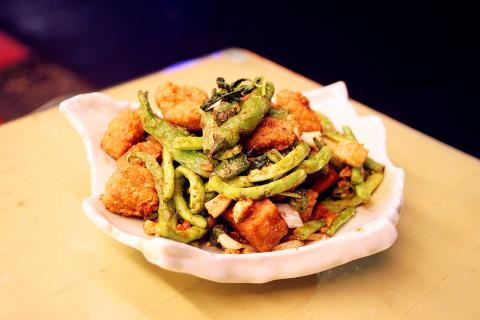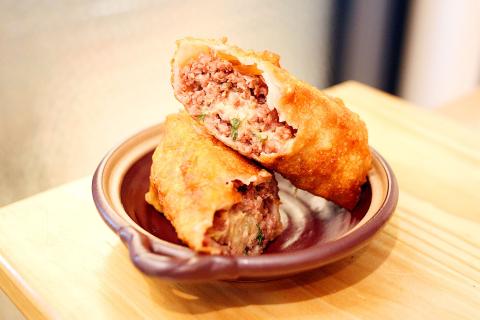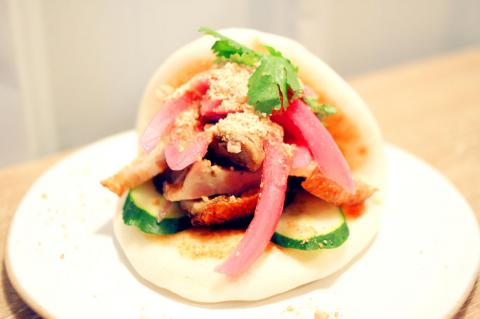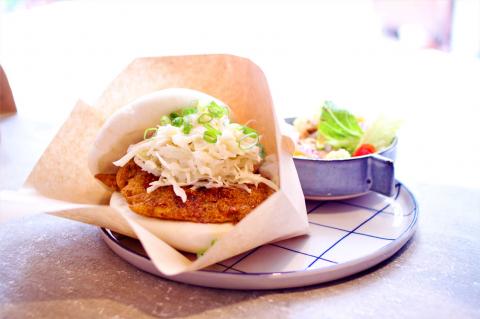In case you needed any proof that Taipei’s food and beverage scene is alive and well, young and independent restaurateurs are continuing to strike out on their own with unconventional takes on local cuisine.
They may not have big backers, but from humble spaces and with concentrated menus, they are reenergizing the Taiwanese table with delicious, youthful irreverence.
CHU ZHA SNACK SHOP

Photo: Davina Tham, Taipei Times
The female duo behind this fry station has unusual pedigree, as street vendors go. Both were previously at Italian restaurant Popina, and that finesse and European influence are apparent — this is no ordinary Taiwanese popcorn chicken (鹹酥雞) stand.
Although “snack shop” (小食) is in the name, I had no trouble culling a full meal from the menu. Staples of the deep-fried genre are plentiful, including popcorn chicken (NT$55), chicken cartilage (NT$55) and skin (NT$30) and silver-stripe round herring (丁香魚, NT$60). Even daily servings of vegetables can be fulfilled with long beans (NT$30) and sweet chili peppers (NT$30).
Unlike many popcorn chicken stands, which tend to disappoint with stringy meat and gluey batter, Chu Zha’s version is succulent and achieves a crust just thin enough to carry the necessary crunch and chili powder. Another mark of thoughtful cooking is that the chicken is seasoned all the way through, rather than falling back on an external dusting of condiments.

Photo: Davina Tham, Taipei Times
And despite the exponential increase in quality, the quantity does not suffer too much — I count 11 pieces in a single order.
Non-meat ingredients are handled with just as much care. Handmade taro cake (NT$30) is smooth, chewy and perfumed with dried shrimp. Oyster mushrooms (NT$30) stay juicy within a crisp exterior. Sweet potato fries (NT$25) are paired with a sprinkling of sour plum powder to accentuate their natural sugars.
A portion of the menu is also dedicated to foods that have first been braised in lu (滷) gravy before being deep-fried — think pig’s trotters (NT$90), five-spice tofu (NT$25) and pig’s intestines stuffed with glutinous rice (NT$30).

Photo: Davina Tham, Taipei Times
Despite my plate being piled high with a mixture of deep-fried morsels, all topped with the same raw garlic, onion and chili powder, each ingredient is cooked perfectly and tastes distinct.
The above are just the basics, which are more than met at this point. But where the chefs’ skill and personality really come through is in the rotating chalkboard specials, which elevate the Taiwanese deep-fry to something quite special.
A fritter of beef mince laced with tuna (NT$90) is Chu Zha’s take on vitello tonnato, a traditional Piedmontese dish of thinly sliced veal and tuna sauce. This may not sound like an intuitive surf-and-turf combination, but it’s a classic for a reason. Briny tuna amplifies the savoriness of the beef, giving it a well-roundedness that eludes even some restaurant entrees.

Photo: Davina Tham, Taipei Times
Shredded duck meat and lotus root (NT$80) cooked in Angelica sinensis (當歸) achieves layered textures in a neat package, as toothsome as it is intriguing. But what every regular asks after are the deep-fried peppers filled with beef mince and Gouda cheese (NT$60), which have a tendency to sell out mid-week. Like a Taiwanese jalapeno popper, these are the perfect accompaniment to a chilled European or South American beer (NT$150).
For the dessert course, a fritter of handmade taro paste with dark chocolate filling (NT$30) is subtly sweet, but is also not as compelling as the savory options.
With just 10 seats, Chu Zha’s shop space is as petite as the two women behind its counter. But there’s an understated aggressiveness to this joint, one that extends from the raging hot oil of the deep fryer, to the creative ambition of its chefs.
Chu Zha Snack Shop
(初炸小食店)
Address: 57, Ln 308, Guangfu S Rd, Taipei City
(台北市光復南路308巷57號)
Telephone: (02) 2776-5855
Open: Sunday to Thursday, 3pm to 11pm; Friday to Saturday, 3pm to midnight
Average meal: NT$180
Details: Menu in Chinese; cash only
On the Net: www.facebook.com/DeepFry2018
MAN BAO
Chifeng Street (赤峰街) in Datong District (大同) houses an intriguing mix of new, design-conscious cafes and restaurants alongside mom-and-pop stores and vehicle maintenance garages.
Like a symbol of that juxtaposition, Man Bao is a chic nine-seater bistro serving reinvigorated versions of guabao (割包), the steamed bun traditionally filled with braised pork belly. Here the guabao becomes more properly like a Taiwanese burger, with separate buns sandwiching varied fillings.
The usual fatty pork is best traded in for lean, tender chicken breast served two ways — with a homemade mala spicy sauce and coleslaw (NT$230) or with a sweet glaze and caramelized pineapple ring (NT$220). Both versions, which come with a side salad, are mouthwatering and unexpectedly satiating.
Sliced pork and kimchi (NT$220) also make perfect sense as guabao filling, together with a homemade Korean-style honey and chili sauce. And despite their fluffiness, the pristine white buns stand up respectably to the saucy fillings.
Truth be told, it’s no replacement for the original guabao. But these lighter renditions will do for health-conscious diners or those seeking a bit of cultural fusion, as evidenced by the largely teenage crowd there when I visited.
Man Bao (饅飽)
Address: 2, Ln 77, Chifeng St, Taipei City (台北市赤峰街77巷2號)
Open: Tuesday to Saturday, 11am to 7:30pm; Sunday, 11am to 6pm
Average meal: NT$300
Details: Menu in Chinese; cash only
On the Net: www.facebook.com/manbaomb
GO HOME TO EAT
Located within a warren of roadside market stalls amd sharing a shopfront with a fish paste vendor, Go Home to Eat is an unlikely find in its neighborhood. The restaurant styles itself as a home cook’s kitchen serving hearty but unpretentious food, and by that standard, it delivers.
This might be the only commercial kitchen in the city that simultaneously turns out decent versions of guabao, biandang (便當, or Taiwanese lunch boxes), pasta and pizza.
Unlike Man Bao, the guabao (NT$80) here is closer to the classic version, complete with a sprinkle of crushed peanuts and vividly pink pickled onions for acidity. But instead of a quivering, melting slab of fatty pork, it’s filled with pork belly that has been roasted until the top layer of skin and fat renders to a crunchy, salty topping. The same pork is served with a fried egg and rice (NT$250) to make an elegant lunch box.
Pasta of this caliber is a refreshing find in this part of town. Handmade noodles tossed with fresh green pesto (NT$220) come with mushrooms or, for a change, local squid sausage. And presentation is done with flair — charred cherry tomatoes ring my plate of pasta, which is topped with a shower of grated parmesan.
Given the chef’s curious dexterity with both Italian and Taiwanese cooking, I’m also drawn to the naturally leavened pizzas with margherita, pesto and cheese toppings (NT$220 to NT$270).
Capitalizing on nostalgia, Go Home to Eat pairs up with Recovering Childhood (小時候雞排) — the fried chicken cutlet shop with a Freudian name that lies on its doorstep — so that diners can also savor chicken while seated in the restaurant. It’s also taken to naming its drinks with a nod to the olden days, such as English tea with milk (NT$55) from “when we were young.”
Go Home to Eat (回家吃)
Address: 48-3, Ln 370, Longjiang Rd, Taipei City
(台北市龍江路370巷48-3號)
Telephone: 0916-699-405
Open: Tuesday to Sunday, 8:30am to 5pm
Average meal: NT$280
Details: Menu in Chinese; cash only
On the Net: www.facebook.com/GoHomeToEat

This month the government ordered a one-year block of Xiaohongshu (小紅書) or Rednote, a Chinese social media platform with more than 3 million users in Taiwan. The government pointed to widespread fraud activity on the platform, along with cybersecurity failures. Officials said that they had reached out to the company and asked it to change. However, they received no response. The pro-China parties, the Chinese Nationalist Party (KMT) and Taiwan People’s Party (TPP), immediately swung into action, denouncing the ban as an attack on free speech. This “free speech” claim was then echoed by the People’s Republic of China (PRC),

Exceptions to the rule are sometimes revealing. For a brief few years, there was an emerging ideological split between the Democratic Progressive Party (DPP) and Chinese Nationalist Party (KMT) that appeared to be pushing the DPP in a direction that would be considered more liberal, and the KMT more conservative. In the previous column, “The KMT-DPP’s bureaucrat-led developmental state” (Dec. 11, page 12), we examined how Taiwan’s democratic system developed, and how both the two main parties largely accepted a similar consensus on how Taiwan should be run domestically and did not split along the left-right lines more familiar in

Specialty sandwiches loaded with the contents of an entire charcuterie board, overflowing with sauces, creams and all manner of creative add-ons, is perhaps one of the biggest global food trends of this year. From London to New York, lines form down the block for mortadella, burrata, pistachio and more stuffed between slices of fresh sourdough, rye or focaccia. To try the trend in Taipei, Munchies Mafia is for sure the spot — could this be the best sandwich in town? Carlos from Spain and Sergio from Mexico opened this spot just seven months ago. The two met working in the

Many people in Taiwan first learned about universal basic income (UBI) — the idea that the government should provide regular, no-strings-attached payments to each citizen — in 2019. While seeking the Democratic nomination for the 2020 US presidential election, Andrew Yang, a politician of Taiwanese descent, said that, if elected, he’d institute a UBI of US$1,000 per month to “get the economic boot off of people’s throats, allowing them to lift their heads up, breathe, and get excited for the future.” His campaign petered out, but the concept of UBI hasn’t gone away. Throughout the industrialized world, there are fears that